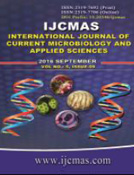


 National Academy of Agricultural Sciences (NAAS)
National Academy of Agricultural Sciences (NAAS)

|
PRINT ISSN : 2319-7692
Online ISSN : 2319-7706 Issues : 12 per year Publisher : Excellent Publishers Email : editorijcmas@gmail.com / submit@ijcmas.com Editor-in-chief: Dr.M.Prakash Index Copernicus ICV 2018: 95.39 NAAS RATING 2020: 5.38 |
Urinary tract infections (UTI) have the potential for serious and life-threatening sequelae if left untreated or poorly treated. Empirical antibiotics treatment may be warranted in the face of symptomatic infections pending availability of laboratory results, hence the need to study the prevalent pathogen in a particular location and its susceptibility pattern to enable healthcare providers make informed decision on their choice of drug treatment for patients. We review 1,658 suspected cases of Urinary Tract Infections analysed between January 2014 and September 2015 (20 months) for bacterial isolates and their antibiotic susceptibility pattern. The results showed that there were 856 females and 802 males. Majority of the males were >40 years of age (55.49%) while majority of the females were between 21-40 years age group(62.74%). Organisms isolated include E.coli (54.42%), Pseudomonas spp (6.19%), Klebsiella spp (20.13%), Proteus spp (14.38%), Enterococcus feacalis (4.87%) All isolates had some level of resistance to each antibiotic tested. Ceftriaxone (65%) showed highest level of sensitivity to E. coli, followed by ofloxacin (58.5%), ciprofloxacin (56.5%), and levofloxacin (51.2%). Lowest level of sensitivity to erythromycin (8.9%) and cotrimoxazole (1.6%) was seen among isolates. All isolates were however found to have appreciable sensitivity to Ofloxacin. E.feacalis isolate had 100% sensitivity to Ofloxacin, levonofloxacin, and cotrimoxazole. in contrast to 50% sensitivity to Augmentin. The low level of sensitivity seen in this study is not unconnected to the poor regulation of antibiotic usage in our environment. This is a heavy challenge to the Ministry of Health and other stakeholders in our health sector.
 |
 |
 |
 |
 |